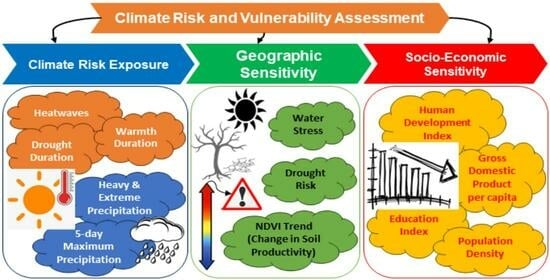Climate Risk and Vulnerability Assessment of Georgian Hydrology under Future Climate Change Scenarios
Abstract
:1. Introduction
2. Materials and Methods
2.1. Study Area
2.1.1. Climate
2.1.2. Hydrology
2.2. Climate Change Outlook
2.2.1. Annual mean Temperature
2.2.2. Heat Waves
2.2.3. Annual Total Precipitation/Precipitation Seasonality
2.3. Methodology
2.3.1. Global Climate Models (GCMs)
2.3.2. ETCCDI Extreme Climate Indices (Climate Exposure Indicators)
2.3.3. Geographic Indicators
2.3.4. Socio-Economic Indicators
2.3.5. Climate Exposure, Geographic and Socio-Economic Sensitivity, Climate Risk and Vulnerability Index
3. Results and Discussion
3.1. Climate Exposure Assessment
Combined Climate Exposure Map
3.2. Geographic Sensitivity Assessment
Combined Geographic Sensitivity Map
3.3. Socio-Economic Sensitivity Assessment
Combined Socio-Economic Sensitivity Map
3.4. Climate Risk and Vulnerability Map
3.5. Limitations
- Climate change simulated using climate models must undergo significance testing to determine the reliability of the simulation results compared to the model’s internal variability. Although this study utilized an ensemble mean of selected GCMs to decrease uncertainty and model internal variability to some extent, carrying out significance testing on the GCMs would provide further accuracy and confidence to the results.
- This study used various indicators from different sources, each with distinct characteristics. The indicators were measured or determined using different baseline periods. This study carefully selected the indicators and data sources. The indicators used for this study are widely used and accepted by the research community. This approach was adopted to ensure that the methods of calculating the CRVA remain simple to replicate in other regions.
- As per [78], the algorithm used to determine the NDVI selects the optimal pixel value by analyzing all of the data gathered over 16 days, with additional criteria such as less cloud cover, a lower viewing angle, and the highest NDVI value. Therefore, this study trusted the data and used it for the analysis, assuming it underwent some post-processing and validation. However, it is always recommended to conduct additional atmospheric and radiometric corrections to improve the accuracy of the NDVI data.
- The weights used in the equations to determine the exposure risk, sensitivity, and vulnerability index were not chosen solely based on scientific methods. This might raise questions about the reliability of the analysis. These weights are critical for assessing climate risk and vulnerability, so it was necessary to have extensive discussions among different stakeholders in Georgia. Ensuring that all parties involved took and accepted the study’s findings seriously was essential.
- This study utilized the ETCCDI climate indices data from the CMIP5 GCMs. However, it is worth noting that the CMIP6 GCM data have recently become available and have been made publicly accessible. For further research, it may be worthwhile for researchers to calculate extreme climate indices using the CMIP6 data and conduct a CRVA study to examine any potential variations in the outcomes.
4. Conclusions
Author Contributions
Funding
Data Availability Statement
Acknowledgments
Conflicts of Interest
References
- Liang, Y.; Song, W. Integrating Potential Ecosystem Services Losses into Ecological Risk Assessment of Land Use Changes: A Case Study on the Qinghai-Tibet Plateau. J. Environ. Manag. 2022, 318, 115607. [Google Scholar] [CrossRef] [PubMed]
- Sekhri, S.; Kumar, P.; Fürst, C.; Pandey, R. Mountain Specific Multi-Hazard Risk Management Framework (MSMRMF): Assessment and Mitigation of Multi-Hazard and Climate Change Risk in the Indian Himalayan Region. Ecol. Indic. 2020, 118, 106700. [Google Scholar] [CrossRef]
- Fritzsche, K.; Schneiderbauer, S.; Bubeck, P.; Kienberger, S.; Buth, M.; Zebisch, M.; Kahlenborn, W. The Vulnerability Sourcebook: Concept and Guidelines for Standardised Vulnerability Assessments; Deutsche Gesellschaft für Internationale Zusammenarbeit (GIZ) GmbH: Bonn, Germany; Eschborn, Germany, 2014. [Google Scholar]
- CNA Corporation. National Security and the Threat of Climate Change; CNA Corporation: Alexandria, VA, USA, 2007. [Google Scholar]
- Wheeler, T.; Von Braun, J. Climate Change Impacts on Global Food Security. Science 2013, 341, 508–513. [Google Scholar] [CrossRef] [PubMed]
- Li, L.; Wang, B.; Feng, P.; Jägermeyr, J.; Asseng, S.; Müller, C.; Macadam, I.; Liu, D.L.; Waters, C.; Zhang, Y.; et al. The Optimization of Model Ensemble Composition and Size Can Enhance the Robustness of Crop Yield Projections. Commun. Earth Environ. 2023, 4, 362. [Google Scholar] [CrossRef]
- Calzadilla, A.; Rehdanz, K.; Betts, R.; Falloon, P.; Wiltshire, A.; Tol, R.S.J. Climate Change Impacts on Global Agriculture. Clim. Chang. 2013, 120, 357–374. [Google Scholar] [CrossRef]
- Liu, K.; Harrison, M.T.; Yan, H.; Liu, D.L.; Meinke, H.; Hoogenboom, G.; Wang, B.; Peng, B.; Guan, K.; Jaegermeyr, J.; et al. Silver Lining to a Climate Crisis in Multiple Prospects for Alleviating Crop Waterlogging under Future Climates. Nat. Commun. 2023, 14, 765. [Google Scholar] [CrossRef] [PubMed]
- Parker, L.; Bourgoin, C.; Martinez-Valle, A.; Läderach, P. Vulnerability of the Agricultural Sector to Climate Change: The Development of a Pan-Tropical Climate Risk Vulnerability Assessment to Inform Sub-National Decision Making. PLoS ONE 2019, 14, e0213641. [Google Scholar] [CrossRef]
- Kirilenko, A.P.; Sedjo, R.A. Climate Change Impacts on Forestry. Proc. Natl. Acad. Sci. USA 2007, 104, 19697–19702. [Google Scholar] [CrossRef]
- Tol, R.S.J. The Economic Impacts of Climate Change. Rev. Environ. Econ. Policy 2018, 12, 4–25. [Google Scholar] [CrossRef]
- Cutter, S.L.; Boruff, B.J.; Shirley, W.L. Social Vulnerability to Environmental Hazards. Soc. Sci. Q. 2003, 84, 242–261. [Google Scholar] [CrossRef]
- Aryal, A.; Bosch, R.; Lakshmi, V. Climate Risk and Vulnerability Assessment of the Georgian Hydrology (Water Sector) to the Effects of Climate Change. In Proceedings of the AGU Fall Meeting 2022, Chicago, IL, USA, 12–16 December 2022; p. NH45C-0472. [Google Scholar]
- Aryal, A.; Tran, T.N.D.; Kumar, B.; Lakshmi, V. Evaluation of Satellite-Derived Precipitation Products for Streamflow Simulation of a Mountainous Himalayan Watershed: A Study of Myagdi Khola in Kali Gandaki Basin, Nepal. Remote Sens. 2023, 15, 4762. [Google Scholar] [CrossRef]
- Aryal, A.; Tran, T.N.D.; Kim, K.Y.; Rajaram, H.; Lakshmi, V. Climate and Land Use/Land Cover Change Impacts on Hydrological Processes in the Mountain Watershed of Gandaki River Basin, Nepal. In Proceedings of the AGU Fall Meeting 2022, Chicago, IL, USA, 12–16 December 2022; p. H52L-0615. [Google Scholar]
- Tran, T.N.D.; Nguyen, B.Q.; Zhang, R.; Aryal, A.; Grodzka-Łukaszewska, M.; Sinicyn, G.; Lakshmi, V. Quantification of Gridded Precipitation Products for the Streamflow Simulation on the Mekong River Basin Using Rainfall Assessment Framework: A Case Study for the Srepok River Subbasin, Central Highland Vietnam. Remote Sens. 2023, 15, 1030. [Google Scholar] [CrossRef]
- Nguyen, B.Q.; Tran, T.N.D.; Grodzka-Łukaszewska, M.; Sinicyn, G.; Lakshmi, V. Assessment of Urbanization-Induced Land-Use Change and Its Impact on Temperature, Evaporation, and Humidity in Central Vietnam. Water 2022, 14, 3367. [Google Scholar] [CrossRef]
- Gernaat, D.E.H.J.; de Boer, H.S.; Daioglou, V.; Yalew, S.G.; Müller, C.; van Vuuren, D.P. Climate Change Impacts on Renewable Energy Supply. Nat. Clim. Chang. 2021, 11, 119–125. [Google Scholar] [CrossRef]
- Nunez, S.; Arets, E.; Alkemade, R.; Verwer, C.; Leemans, R. Assessing the Impacts of Climate Change on Biodiversity: Is below 2 °C Enough? Clim. Chang. 2019, 154, 351–365. [Google Scholar] [CrossRef]
- Konapala, G.; Mishra, A.K.; Wada, Y.; Mann, M.E. Climate Change Will Affect Global Water Availability through Compounding Changes in Seasonal Precipitation and Evaporation. Nat. Commun. 2020, 11, 3044. [Google Scholar] [CrossRef]
- Pokhrel, Y.; Felfelani, F.; Satoh, Y.; Boulange, J.; Burek, P.; Gädeke, A.; Gerten, D.; Gosling, S.N.; Grillakis, M.; Gudmundsson, L.; et al. Global Terrestrial Water Storage and Drought Severity under Climate Change. Nat. Clim. Chang. 2021, 11, 226–233. [Google Scholar] [CrossRef]
- Gädeke, A.; Krysanova, V.; Aryal, A.; Chang, J.; Grillakis, M.; Hanasaki, N.; Koutroulis, A.; Pokhrel, Y.; Satoh, Y.; Schaphoff, S.; et al. Performance Evaluation of Global Hydrological Models in Six Large Pan-Arctic Watersheds. Clim. Chang. 2020, 163, 1329–1351. [Google Scholar] [CrossRef]
- Tabari, H. Climate Change Impact on Flood and Extreme Precipitation Increases with Water Availability. Sci. Rep. 2020, 10, 13768. [Google Scholar] [CrossRef] [PubMed]
- Wang, X.-j.; Zhang, J.-y.; Shahid, S.; Guan, E.-h.; Wu, Y.-x.; Gao, J.; He, R.-m. Adaptation to Climate Change Impacts on Water Demand. Mitig. Adapt. Strat. Glob. Chang. 2016, 21, 81–99. [Google Scholar] [CrossRef]
- Gigli, S.; Agrawala, S. Stocktaking of Progress on Integrating Adaptation to Climate Change into Development Co-Operation Activities Oecd; OECD: Paris, France, 2007. [Google Scholar]
- IPCC. Summary for Policymakers. In Climate Change 2014: Impacts, Adaptation, and Vulnerability. Part A: Global and Sectoral Aspects. Contribution of Working Group II to the Fifth Assessment Report of the Intergovernmental Panel on Climate Change; Field, C.B., Barros, V.R., Dokken, D.J., Mach, K.J., Mastrandrea, M.D., Bilir, T.E., Chatterjee, M., Ebi, K.L., Estrada, Y.O., Genova, R.C., et al., Eds.; Cambridge University Press: Cambridge, UK; New York, NY, USA, 2014. [Google Scholar]
- Oppenheimer, M.; Campos, M.; Warren, R.; Birkmann, J.; Luber, G.; Takahashi, K.; Berkhout, F.; Brklacich, M.; Semenov, S.; Licker, R.; et al. Emergent risks and key vulnerabilities. In Climate Change 2014: Impacts, Adaptation, and Vulnerability. Part A: Global and Sectoral Aspects. Contribution of Working Group II to the Fifth Assessment Report of the Intergovernmental Panel on Climate Change; Field, C.B., Barros, V.R., Dokken, D.J., Mach, K.J., Mastrandrea, M.D., Bilir, T.E., Chatterjee, M., Ebi, K.L., Estrada, Y.O., Genova, R.C., et al., Eds.; Cambridge University Press: Cambridge, UK; New York, NY, USA, 2014; pp. 1039–1099. [Google Scholar]
- Fünfgeld, H.; Mcevoy, D. Framing Climate Change Adaptation in Policy and Practice; Victorian Centre for Climate Change Adaptation Research: Melbourne, Australia, 2011. [Google Scholar]
- Jurgilevich, A.; Räsänen, A.; Groundstroem, F.; Juhola, S. A Systematic Review of Dynamics in Climate Risk and Vulnerability Assessments. Environ. Res. Lett. 2017, 12, 013002. [Google Scholar] [CrossRef]
- Preston, B.L.; Yuen, E.J.; Westaway, R.M. Putting Vulnerability to Climate Change on the Map: A Review of Approaches, Benefits, and Risks. Sustain. Sci. 2011, 6, 177–202. [Google Scholar] [CrossRef]
- GIZ. A Framework for Climate Change Vulnerability Assessments; Deutsche Gesellschaft für Internationale Zusammenarbeit (GIZ) GmbH: New Delhi, India, 2014. [Google Scholar]
- GIZ; EURAC. Risk Supplement to the Vulnerability Sourcebook. Guidance on How to Apply the Vulnerability Sourcebook’s Approach with the New IPCC AR5 Concept of Climate Risk; Deutsche Gesellschaft für Internationale Zusammenarbeit (GIZ) GmbH: Bonn, Germany, 2017. [Google Scholar]
- GIZ; EURAC; UNU-EHS. Climate Risk Assessment for Ecosystem-Based Adaptation—A Guidebook for Planners and Practitioners; Deutsche Gesellschaft für Internationale Zusammenarbeit (GIZ) GmbH: Bonn, Germany, 2018. [Google Scholar]
- Estoque, R.C.; Ooba, M.; Togawa, T.; Yoshioka, A.; Gomi, K.; Nakamura, S.; Tsuji, T.; Hijioka, Y.; Watanabe, M.; Kitahashi, M. Climate Impact Chains for Envisaging Climate Risks, Vulnerabilities, and Adaptation Issues. Reg. Environ. Chang. 2022, 22, 133. [Google Scholar] [CrossRef]
- Menk, L.; Terzi, S.; Zebisch, M.; Rome, E.; Lückerath, D.; Milde, K.; Kienberger, S. Climate Change Impact Chains: A Review of Applications, Challenges, and Opportunities for Climate Risk and Vulnerability Assessments. Weather. Clim. Soc. 2022, 14, 619–636. [Google Scholar] [CrossRef]
- Schneiderbauer, S.; Zebisch, M.; Kass, S.; Pedoth, L. Assessment of Vulnerability to Natural Hazards and Climate Change in Mountain Environments–Examples from the Alps. In Measuring Vulnerability; Birkmann, J., Ed.; United University Press: Tokyo, Japan, 2013; pp. 349–380. [Google Scholar]
- Schneiderbauer, S.; Baunach, D.; Pedoth, L.; Renner, K.; Fritzsche, K.; Bollin, C.; Pregnolato, M.; Zebisch, M.; Liersch, S.; López, M.d.R.R.; et al. Spatial-Explicit Climate Change Vulnerability Assessments Based on Impact Chains. Findings from a Case Study in Burundi. Sustainability 2020, 12, 6354. [Google Scholar] [CrossRef]
- Zebisch, M.; Terzi, S.; Pittore, M.; Renner, K.; Schneiderbauer, S. Climate Impact Chains—A Conceptual Modelling Approach for Climate Risk Assessment in the Context of Adaptation Planning. In Climate Adaptation Modelling; Springer International Publishing: Cham, Switzerland, 2022; pp. 217–224. [Google Scholar] [CrossRef]
- Zebisch, M.; Schneiderbauer, S.; Fritzsche, K.; Bubeck, P.; Kienberger, S.; Kahlenborn, W.; Schwan, S.; Below, T. The Vulnerability Sourcebook and Climate Impact Chains—A Standardised Framework for a Climate Vulnerability and Risk Assessment. Int. J. Clim. Chang. Strat. Manag. 2021, 13, 35–59. [Google Scholar] [CrossRef]
- Heltberg, R.; Bonch-Osmolovskiy, M. Mapping Vulnerability to Climate Change; World Bank Policy Research Working Paper No. 5554. 2011. Available online: https://ssrn.com/abstract=1754347 (accessed on 10 October 2023).
- Schneiderbauer, S.; Zebisch, M.; Renner, K.; Brossmann, M.; Ederer, W.; Schwan, S.; Below, T.; Bertram, M. The Vulnerability Sourcebook. Standardised Vulnerability and Risk Assessments to Support Adaptation Planning and Evaluation; Climate Risk Community of Practice (CoP) Launch Event. 2018. Available online: https://bia.unibz.it/esploro/outputs/conferencePoster/The-Vulnerability-Sourcebook-Standardised-vulnerability-and/991005773346801241#file-0 (accessed on 10 October 2023).
- Füssel, H.M.; Klein, R.J.T. Climate Change Vulnerability Assessments: An Evolution of Conceptual Thinking. Clim. Chang. 2006, 75, 301–329. [Google Scholar] [CrossRef]
- IPCC. Climate Change 2007: Impacts, Adaptation and Vulnerability. Contribution of Working Group II to the Fourth Assessment Report of the Intergovernmental Panel on Climate Change; Parry, M.L., Canziani, O.F., Palutikof, J.P., van Der Linden, P.J., Hanson, C.E., Eds.; Cambridge University Press: Cambridge, UK, 2007. [Google Scholar]
- Cardona, O.-D.; van Aalst, M.K.; Birkmann, J.; Fordham, M.; McGregor, G.; Perez, R.; Pulwarty, R.S.; Lisa Schipper, E.F.; Tan Sinh, B.; Décamps, H.; et al. Determinants of Risk: Exposure and Vulnerability. In Managing the Risks of Extreme Events and Disasters to Advance Climate Change Adaptation, A Special Report of Working Groups I and II of the Intergovernmental Panel on Climate Change (IPCC); Field, C.B., Barros, V., Stocker, T.F., Qin, D., Dokken, D.J., Ebi, K.L., Mastrandrea, M.D., Mach, K.J., Plattner, G.-K., Allen, S.K., et al., Eds.; Cambridge University Press: Cambridge, UK; New York, NY, USA, 2012; pp. 65–108. [Google Scholar]
- Estoque, R.C.; Ooba, M.; Seposo, X.T.; Togawa, T.; Hijioka, Y.; Takahashi, K.; Nakamura, S. Heat Health Risk Assessment in Philippine Cities Using Remotely Sensed Data and Social-Ecological Indicators. Nat. Commun. 2020, 11, 1581. [Google Scholar] [CrossRef]
- Schilling, J.; Hertig, E.; Tramblay, Y.; Scheffran, J. Climate Change Vulnerability, Water Resources and Social Implications in North Africa. Reg. Environ. Chang. 2020, 20, 15. [Google Scholar] [CrossRef]
- Zhang, M.; Liu, Z.; Van Dijk, M.P. Measuring Urban Vulnerability to Climate Change Using an Integrated Approach, Assessing Climate Risks in Beijing. PeerJ 2019, 2019, e7018. [Google Scholar] [CrossRef] [PubMed]
- Leis, J.L.; Kienberger, S. Climate Risk and Vulnerability Assessment of Floods in Austria: Mapping Homogenous Regions, Hotspots and Typologies. Sustainability 2020, 12, 6458. [Google Scholar] [CrossRef]
- Leal Filho, W.; Modesto, F.; Nagy, G.J.; Saroar, M.; YannickToamukum, N.; Ha’apio, M. Fostering Coastal Resilience to Climate Change Vulnerability in Bangladesh, Brazil, Cameroon and Uruguay: A Cross-Country Comparison. Mitig. Adapt. Strat. Glob. Chang. 2018, 23, 579–602. [Google Scholar] [CrossRef]
- Aryal, J.P.; Sapkota, T.B.; Rahut, D.B.; Krupnik, T.J.; Shahrin, S.; Jat, M.L.; Stirling, C.M. Major Climate Risks and Adaptation Strategies of Smallholder Farmers in Coastal Bangladesh. Environ. Manag. 2020, 66, 105–120. [Google Scholar] [CrossRef]
- Gemeda, D.O.; Korecha, D.; Garedew, W. Climate Change Perception and Vulnerability Assessment of the Farming Communities in the Southwest Parts of Ethiopia. Climate 2023, 11, 183. [Google Scholar] [CrossRef]
- National Statistics Office of Georgia. Available online: https://www.geostat.ge/en (accessed on 15 June 2022).
- Tielidze, L.G.; Wheate, R.D. The Greater Caucasus Glacier Inventory (Russia, Georgia and Azerbaijan). Cryosphere 2018, 12, 81–94. [Google Scholar] [CrossRef]
- Notarnicola, C. Hotspots of Snow Cover Changes in Global Mountain Regions over 2000–2018. Remote Sens. Environ. 2020, 243, 111781. [Google Scholar] [CrossRef]
- Group, W.B.; Bank, A.D. Climate Risk Country Profile: Georgia; World Bank Publications, The World Bank Group: Washington, DC, USA, 2021. [Google Scholar]
- AQUASTAT|Land; Water|Food and Agriculture Organization of the United Nations|Land; Water|Food and Agriculture Organization of the United Nations. Available online: https://www.fao.org/land-water/databases-and-software/aquastat/en/ (accessed on 10 June 2022).
- OpenTopography-NASADEM Global Digital Elevation Model. Available online: https://portal.opentopography.org/datasetMetadata?otCollectionID=OT.032021.4326.2 (accessed on 11 June 2022).
- Lehner, B.; Verdin, K.; Jarvis, A. New Global Hydrography Derived from Spaceborne Elevation Data. Eos Trans. Am. Geophys. Union 2008, 89, 93–94. [Google Scholar] [CrossRef]
- Buchhorn, M.; Lesiv, M.; Tsendbazar, N.E.; Herold, M.; Bertels, L.; Smets, B. Copernicus Global Land Cover Layers—Collection 2. Remote Sens. 2020, 12, 108. [Google Scholar] [CrossRef]
- Land Cover|Copernicus Global Land Service. Available online: https://land.copernicus.eu/global/products/lc (accessed on 12 June 2022).
- GERICS. Climate-Fact-Sheets, Updated Version 2015; Georgia; Helmholtz-Zentrum Geesthacht Zentrum für Material-und Küstenforschung GmbH, GERICS: Hamburg, Germany, 2015. [Google Scholar]
- Hinkel, J. “Indicators of Vulnerability and Adaptive Capacity”: Towards a Clarification of the Science-Policy Interface. Glob. Environ. Chang. 2011, 21, 198–208. [Google Scholar] [CrossRef]
- Thibeault, J.M.; Seth, A. Changing Climate Extremes in the Northeast United States: Observations and Projections from CMIP5. Clim. Chang. 2014, 127, 273–287. [Google Scholar] [CrossRef]
- Cannon, A.J. Selecting GCM Scenarios That Span the Range of Changes in a Multimodel Ensemble: Application to CMIP5 Climate Extremes Indices. J. Clim. 2015, 28, 1260–1267. [Google Scholar] [CrossRef]
- Lee, J.-H. Analysis of Water Resources and Water Conflicts in Korea Using Aqueduct 3.0 and Water Conflict Chronology. In Proceedings of the Korea Water Resources Association Conference, Daegu, Republic of Korea, 6 October 2023; p. 395. [Google Scholar]
- Chen, P.Y.; Fedosejevs, G.; Tiscareño-López, M.; Arnold, J.G. Assessment of MODIS-EVI, MODIS-NDVI and VEGETATION-NDVI Composite Data Using Agricultural Measurements: An Example at Corn Fields in Western Mexico. Environ. Monit. Assess. 2006, 119, 69–82. [Google Scholar] [CrossRef] [PubMed]
- Eckert, S.; Hüsler, F.; Liniger, H.; Hodel, E. Trend Analysis of MODIS NDVI Time Series for Detecting Land Degradation and Regeneration in Mongolia. J. Arid Environ. 2015, 113, 16–28. [Google Scholar] [CrossRef]
- Mendez, C.; Santos-Marquez, F. Economic and Social Disparities across Subnational Regions of South America: A Spatial Convergence Approach. Comp. Econ. Stud. 2022, 64, 582–605. [Google Scholar] [CrossRef]
- Hofste, R.W.; Kuzma, S.; Walker, S.; Sutanudjaja, E.H.; Bierkens, M.F.P.; Kuijper, M.J.M.; Sanchez, M.F.; Van Beek, R.; Wada, Y.; Rodríguez, S.G.; et al. Aqueduct 3.0: Updated Decision-Relevant Global Water Risk Indicators. 2018. Available online: https://www.wri.org/research/aqueduct-30-updated-decision-relevant-global-water-risk-indicators (accessed on 25 June 2022).
- Asokan, S.M.; Rogberg, P.; Bring, A.; Jarsjö, J.; Destouni, G. Climate Model Performance and Change Projection for Freshwater Fluxes: Comparison for Irrigated Areas in Central and South Asia. J. Hydrol. Reg. Stud. 2016, 5, 48–65. [Google Scholar] [CrossRef]
- Ta, Z.; Yu, Y.; Sun, L.; Chen, X.; Mu, G.; Yu, R. Assessment of Precipitation Simulations in Central Asia by CMIP5 Climate Models. Water 2018, 10, 1516. [Google Scholar] [CrossRef]
- Yu, X.; Zhao, Y.; Ma, X.; Yao, J.; Li, H. Projected Changes in the Annual Cycle of Precipitation over Central Asia by CMIP5 Models. Int. J. Climatol. 2018, 38, 5589–5604. [Google Scholar] [CrossRef]
- Environment Canada-Climate Change-CCCma: Climate Model Data-ETCCDI Extremes Indicies Archive. Available online: https://climate-modelling.canada.ca/climatemodeldata/climdex/ (accessed on 15 June 2022).
- Sillmann, J.; Kharin, V.V.; Zwiers, F.W.; Zhang, X.; Bronaugh, D. Climate Extremes Indices in the CMIP5 Multimodel Ensemble: Part 2. Future Climate Projections. J. Geophys. Res. Atmos. 2013, 118, 2473–2493. [Google Scholar] [CrossRef]
- Sillmann, J.; Kharin, V.V.; Zhang, X.; Zwiers, F.W.; Bronaugh, D. Climate Extremes Indices in the CMIP5 Multimodel Ensemble: Part 1. Model Evaluation in the Present Climate. J. Geophys. Res. Atmos. 2013, 118, 1716–1733. [Google Scholar] [CrossRef]
- Abu Arra, A.; Şişman, E. Characteristics of Hydrological and Meteorological Drought Based on Intensity-Duration-Frequency (IDF) Curves. Water 2023, 15, 3142. [Google Scholar] [CrossRef]
- Aqueduct Global Maps 3.0 Data|World Resources Institute. Available online: https://www.wri.org/data/aqueduct-global-maps-30-data (accessed on 25 June 2022).
- Didan, K. MOD13A1 MODIS/Terra Vegetation Indices 16-Day L3 Global 500m SIN Grid V006 [Data Set]. NASA EOSDIS Land Processes Distributed Active Archive Center. NASA Eosdis Land Process. 2015, 10, 415. [Google Scholar] [CrossRef]
- Subnational Human Development-Global Data Lab. Available online: https://globaldatalab.org/shdi/ (accessed on 10 July 2022).
- Smits, J.; Permanyer, I. The Subnational Human Development Database. Sci. Data 2019, 6, 190038. [Google Scholar] [CrossRef]
- Karger, D.N.; Conrad, O.; Böhner, J.; Kawohl, T.; Kreft, H.; Soria-Auza, R.W.; Zimmermann, N.E.; Linder, H.P.; Kessler, M. Climatologies at High Resolution for the Earth’s Land Surface Areas. Sci. Data 2017, 4, 170122. [Google Scholar] [CrossRef]
- Dryad|Data-Climatologies at High Resolution for the Earth’s Land Surface Areas. Available online: https://datadryad.org/stash/dataset/doi:10.5061/dryad.kd1d4 (accessed on 20 July 2022).
- Varazanashvili, O.; Tsereteli, N.; Amiranashvili, A.; Tsereteli, E.; Elizbarashvili, E.; Dolidze, J.; Qaldani, L.; Saluqvadze, M.; Adamia, S.; Arevadze, N.; et al. Vulnerability, Hazards and Multiple Risk Assessment for Georgia. Nat. Hazards 2012, 64, 2021–2056. [Google Scholar] [CrossRef]
- Davitashvili, T. Natural Disasters and Surface and Subsurface Water Pollution Risk Assessment for Some Regions of Georgia; Springer: Dordrecht, The Netherlands, 2009; pp. 83–89. [Google Scholar] [CrossRef]
- Gaprindashvili, G.; Van Westen, C.J. Generation of a National Landslide Hazard and Risk Map for the Country of Georgia. Nat. Hazards 2016, 80, 69–101. [Google Scholar] [CrossRef]
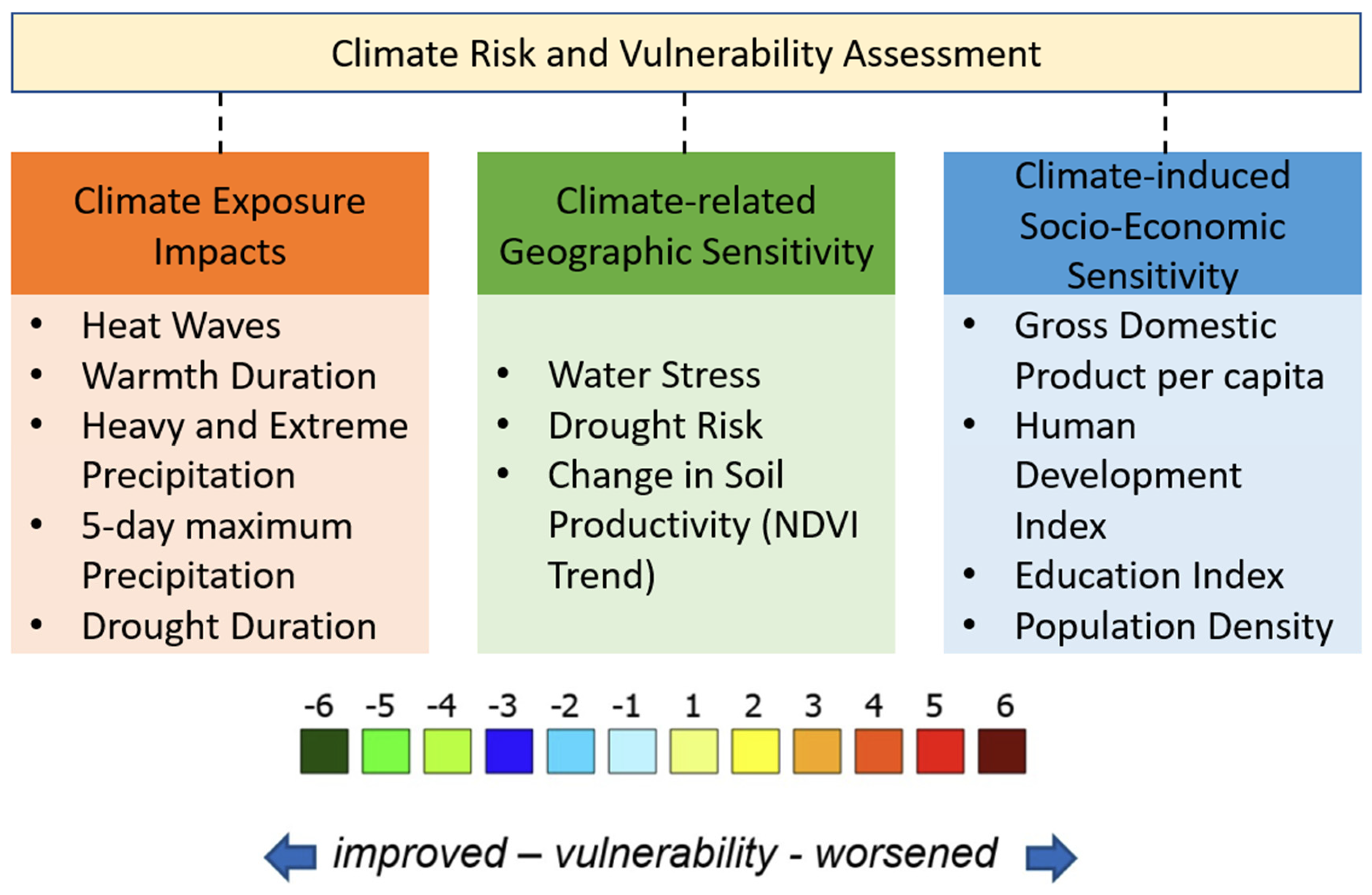

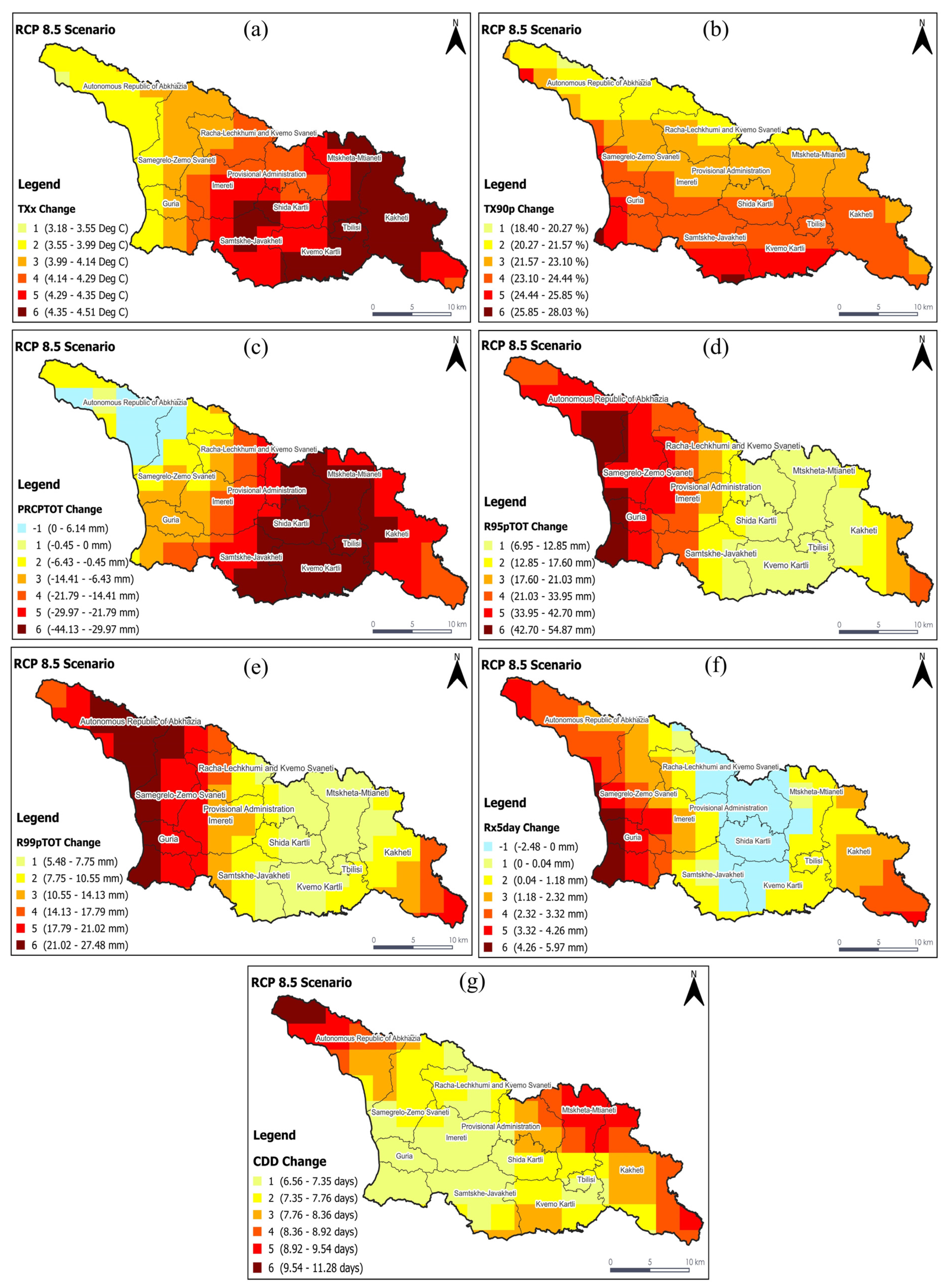
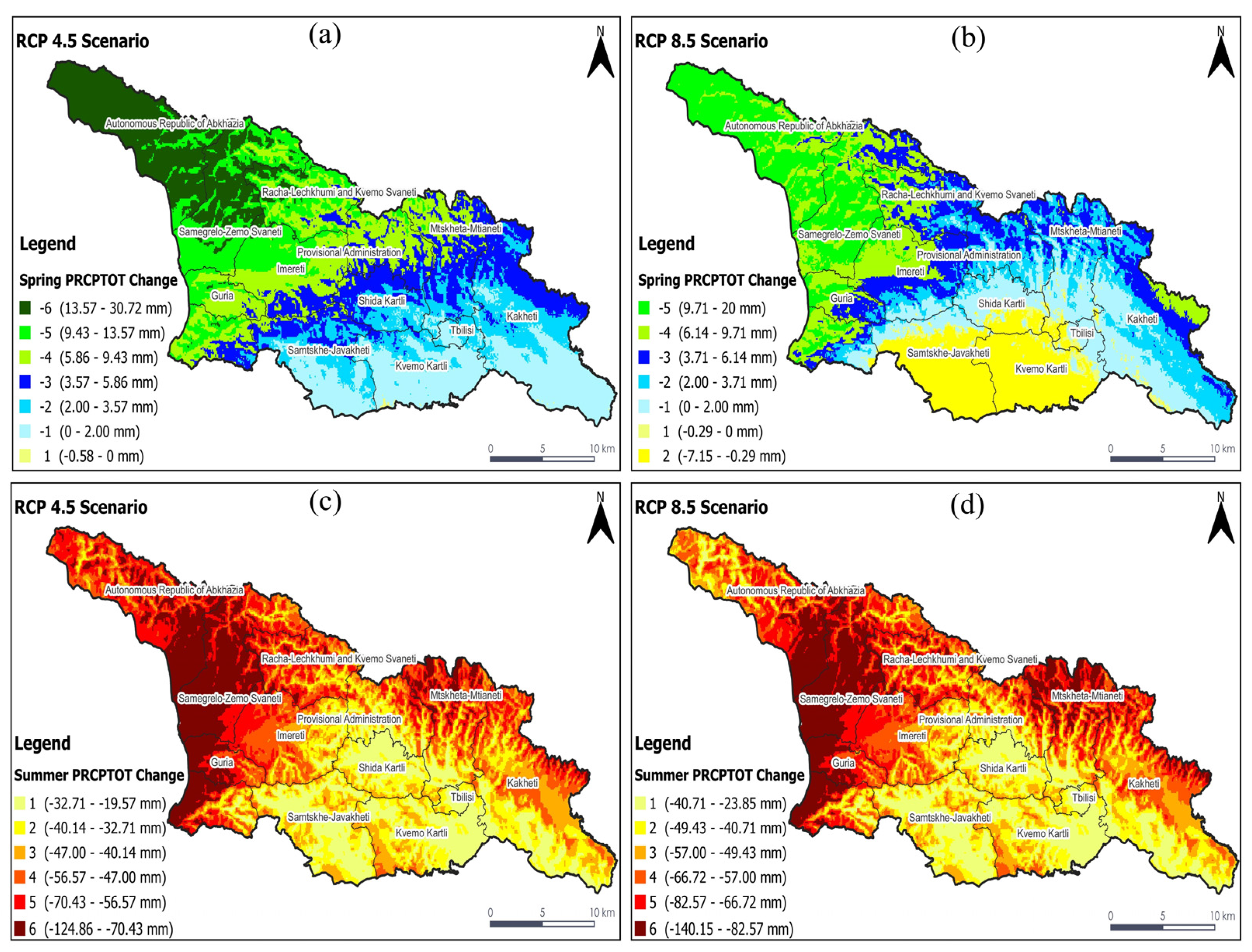

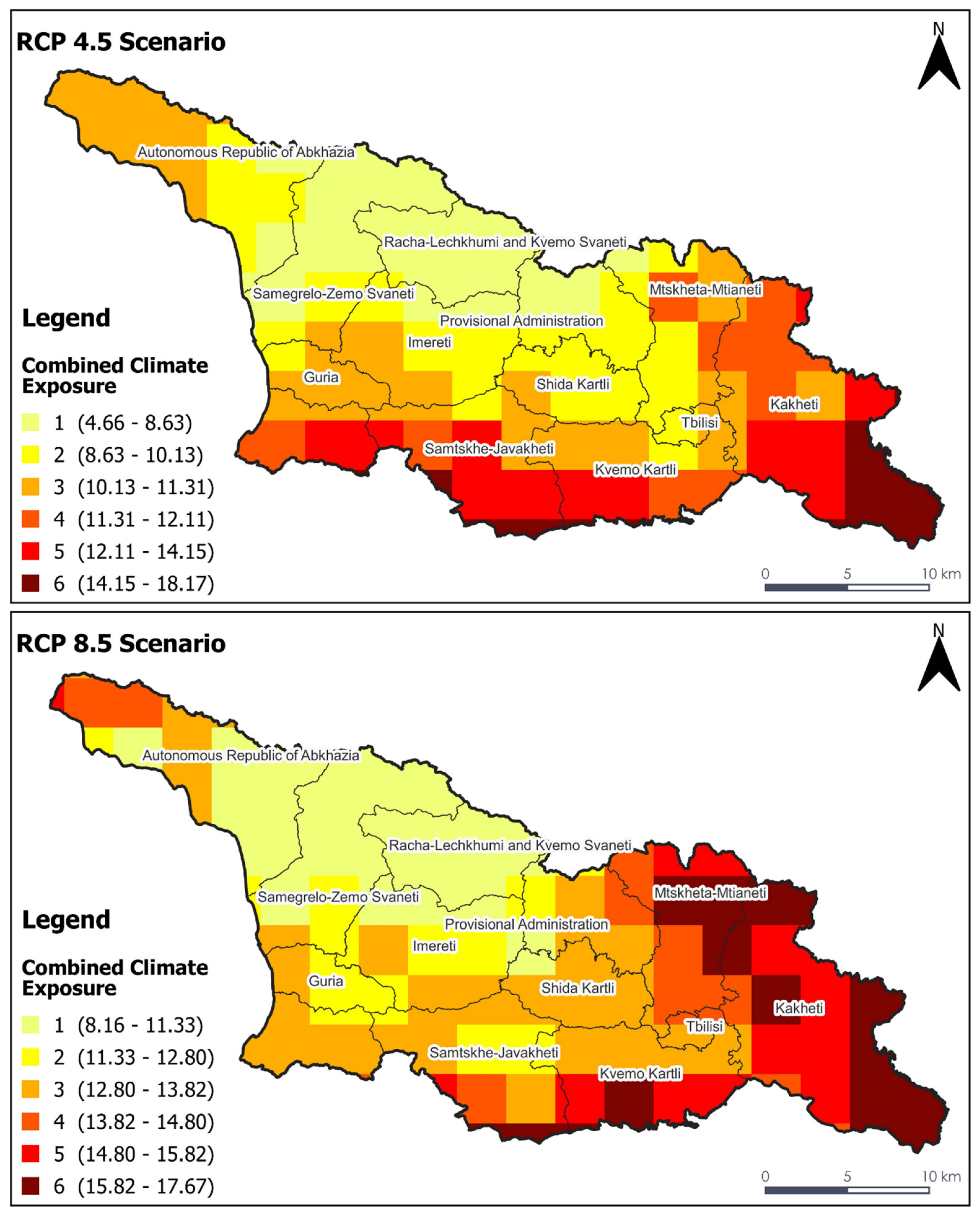

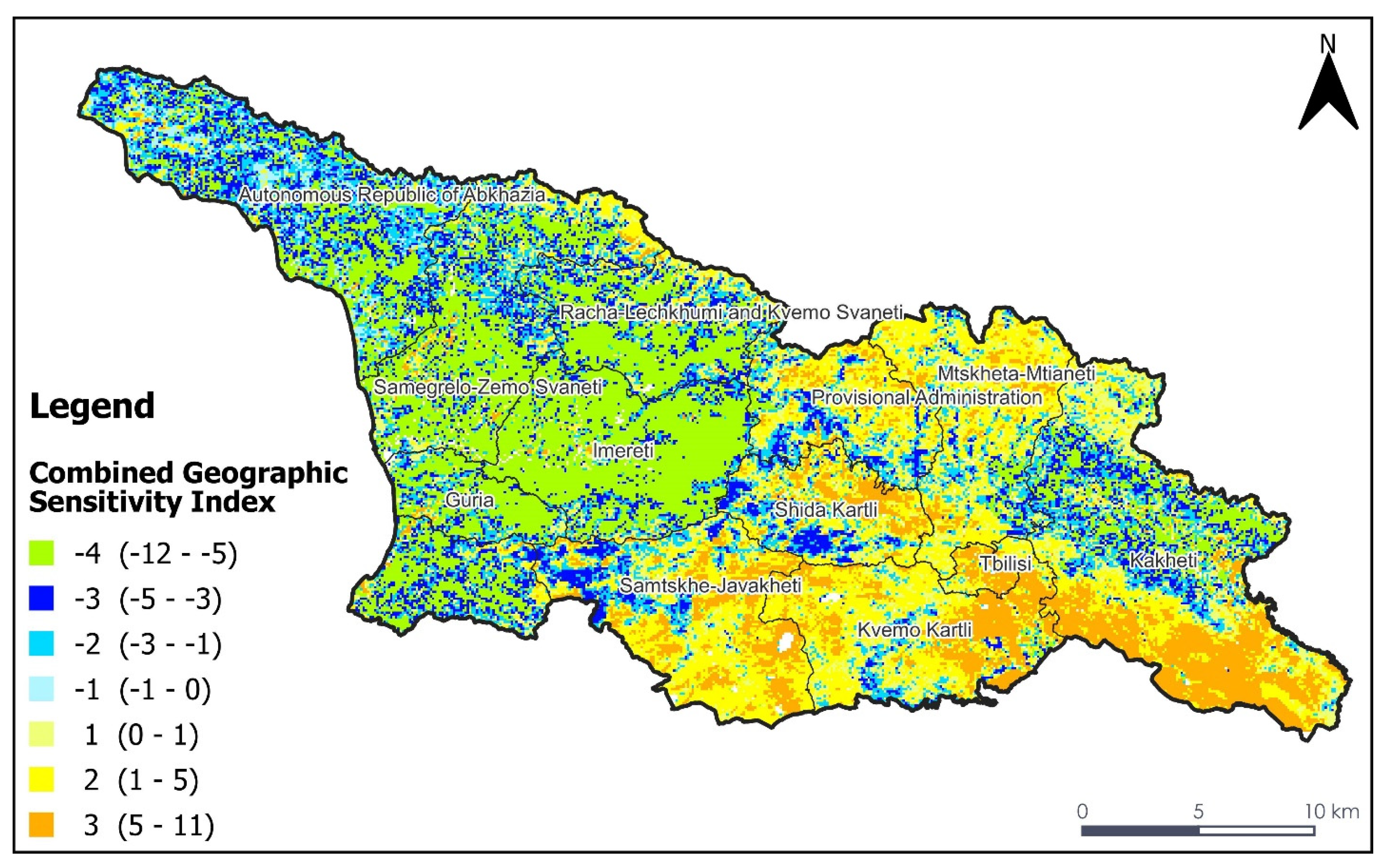
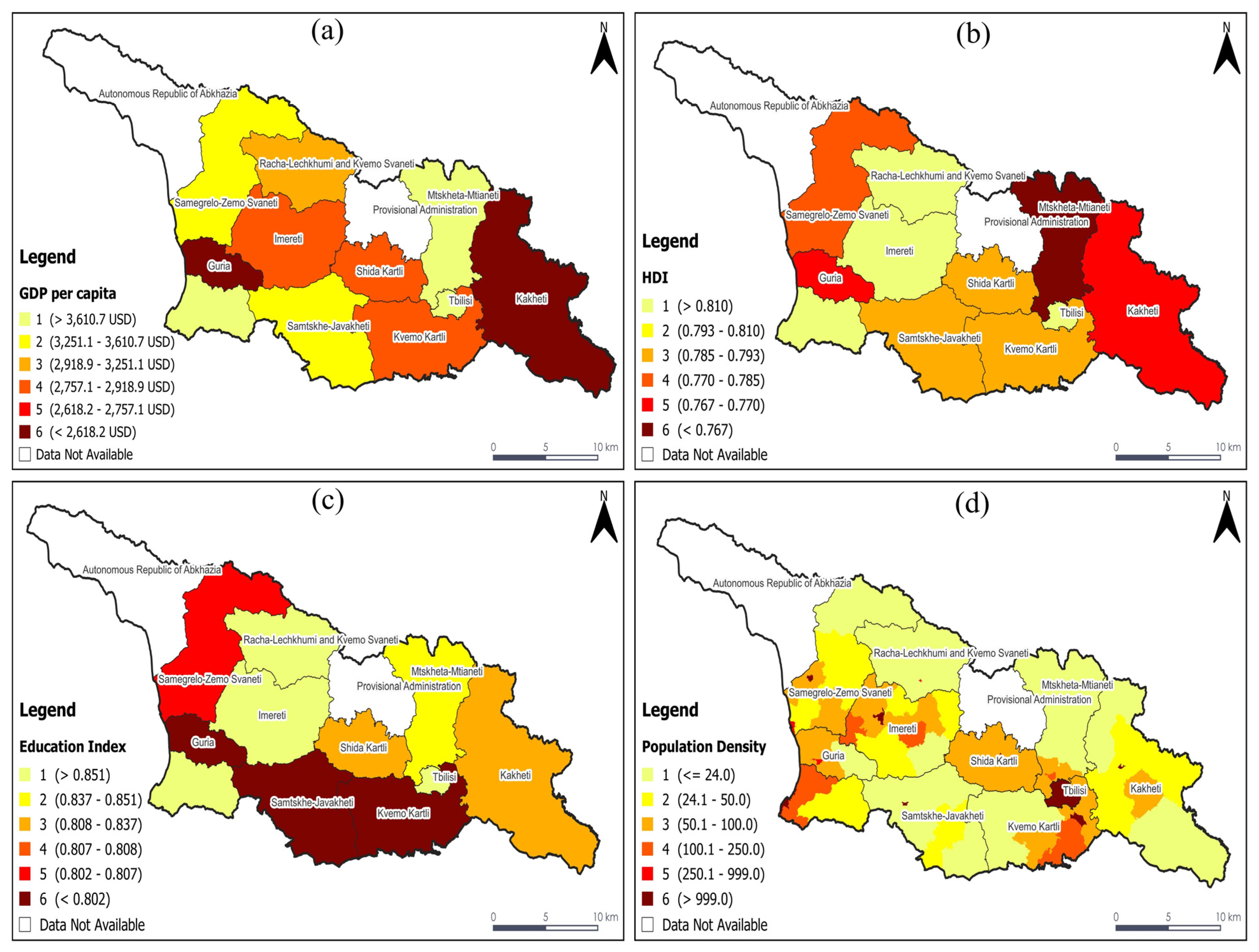


| Scheme | Global Circulation Models | Institution | Spatial Resolution |
|---|---|---|---|
| 1 | CMCC-CM | CMCC, Italy | 0.75° |
| 2 | CSIRO-Mk3.6.0 | CSIRO-QCCCE, Australia | 1.875° |
| 3 | GFDL-ESM2G | NOAA-GFDL, USA | 2.0° |
| 4 | MIROC5 | MIROC, Japan | 1.40625° |
| 5 | MPI-ESM-LR | MPI-M, Germany | 1.875° |
| 6 | MPI-ESM-MR | MPI-M, Germany | 1.875° |
| 7 | MRI-CGCM3 | MRI, Japan | 1.125° |
| S. No. | Extreme Climate Index | Name (Units) | Definition |
|---|---|---|---|
| 1 | PRCPTOT | Total precipitation (mm) | Total annual accumulated precipitation on days with precipitation > 1 mm. |
| 2 | R95pTOT | Heavy precipitation (mm) | Total yearly precipitation on very wet days when daily precipitation is higher than the 95th percentile. |
| 3 | R99pTOT | Extreme precipitation (mm) | Total yearly precipitation on extremely wet days when daily precipitation is higher than the 99th percentile. |
| 4 | Rx5day | 5-day maximum precipitation (mm) | Maximum precipitation in five consecutive days in a year. |
| 5 | TXx | Annual maximum of daily maximum temperature (°C) | Maximum value of daily maximum temperature in a year. |
| 6 | TX90p | Warmth duration (%) | Percentage of warm days when the daily maximum temperature exceeds the 90th percentile. |
| 7 | CDD | Consecutive drought duration (day) | Maximum duration of drought period or maximum number of consecutive days with precipitation below 1 mm in a given year. |
| S. No. | Geographic Indicators | Temporal Coverage | Data Source | References |
|---|---|---|---|---|
| 1 | Water Stress | 1960–2014 | Aqueduct 3.0, WRI | [69,77] |
| 2 | Drought Risk | 2000–2019 | Aqueduct 3.0, WRI | [69,77] |
| 3 | NDVI Trend | 2000–2020 | NASA LP DAAC | [78] |
| S. No. | Geographic Indicators | Temporal Coverage | Data Source | References |
|---|---|---|---|---|
| 1 | GDP per capita | 2020 | National Statistics Office of Georgia | [52] |
| 2 | HDI | 2019 | Global Data Lab | [79,80] |
| 3 | EI | 2020 | National Statistics Office of Georgia | [52] |
| 4 | Population Density | 2020 | National Statistics Office of Georgia | [52] |
| S. No. | Exposure, Sensitivity, and Vulnerability Index | Equation |
|---|---|---|
| 1 | Combined Climate Exposure Index | 0.5 * TXx + 0.5 * TX90p + 1 * PRCPTOT + 0.333 * R95pTOT + 0.333 * R99pTOT + 0.333 * Rx5day + 1 * CDD |
| 2 | Combined Geographic Sensitivity Index | 2 * Water Stress + Drought Risk + 2 * NDVI Trend |
| 3 | Combined Socio-Economic Sensitivity Index | GDP per capita + 0.5 * HDI + 0.5 * EI + 0.5 * Population Density |
| 4 | Climate Risk and Vulnerability Index | Climate Exposure + Geographic Sensitivity + Socio-Economic Sensitivity |
Disclaimer/Publisher’s Note: The statements, opinions and data contained in all publications are solely those of the individual author(s) and contributor(s) and not of MDPI and/or the editor(s). MDPI and/or the editor(s) disclaim responsibility for any injury to people or property resulting from any ideas, methods, instructions or products referred to in the content. |
© 2023 by the authors. Licensee MDPI, Basel, Switzerland. This article is an open access article distributed under the terms and conditions of the Creative Commons Attribution (CC BY) license (https://creativecommons.org/licenses/by/4.0/).
Share and Cite
Aryal, A.; Bosch, R.; Lakshmi, V. Climate Risk and Vulnerability Assessment of Georgian Hydrology under Future Climate Change Scenarios. Climate 2023, 11, 222. https://doi.org/10.3390/cli11110222
Aryal A, Bosch R, Lakshmi V. Climate Risk and Vulnerability Assessment of Georgian Hydrology under Future Climate Change Scenarios. Climate. 2023; 11(11):222. https://doi.org/10.3390/cli11110222
Chicago/Turabian StyleAryal, Aashutosh, Rieks Bosch, and Venkataraman Lakshmi. 2023. "Climate Risk and Vulnerability Assessment of Georgian Hydrology under Future Climate Change Scenarios" Climate 11, no. 11: 222. https://doi.org/10.3390/cli11110222




